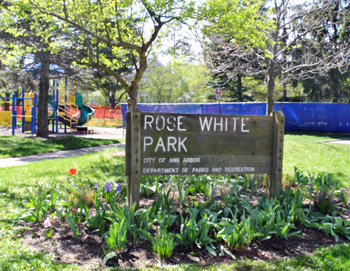Ann Arbor public art commission meeting (April 25, 2012): Two action items on this month’s AAPAC agenda advanced art projects to be located at the East Stadium bridges and Argo Cascades.

From left: Dave Konkle and Tim Jones spoke to the Ann Arbor public art commission about their Whirlydoodle project. Jones invented the device, which is on the table between them and is designed to highlight wind energy. Many others are already installed on light poles and elsewhere throughout downtown Ann Arbor. (Photos by the writer.)
Commissioners approved a $150,000 budget for artwork at the new Huron River bypass near the Argo Pond canoe livery – called Argo Cascades. A task force recommended that the artwork have a “water” theme, and use the bulk of $155,561 that has accumulated from the city’s Percent for Art funds from water-related capital projects. The city will issue a request for artists to submit a statement of qualification (SOQ), and from those submittals a smaller number of artists will be paid $1,000 each to submit formal proposals.
In a separate vote, commissioners approved issuing a request for proposals (RFP) for artwork at the East Stadium bridges. They had previously set a budget of $400,000 for that project, which potentially will incorporate multiple locations on and near the reconstructed bridges.
Several other projects were discussed at the April 25 meeting, but no formal action was taken. During public commentary, commissioners heard from Dave Konkle and Tim Jones regarding a large Whirlydoodle installation they hope to build. The devices were invented by Jones as miniature wind generators, with LED lights that vary in color depending on wind speed – about two dozen are currently placed around the downtown area. A large-scale installation would help people to visualize wind currents and prompt a discussion about alternative energy, he said.
Konkle is the city’s former energy coordinator who now does consulting work for the Ann Arbor Downtown Development Authority as energy programs director. He told commissioners that a display of 1,000 Whirlydoodles – possible at the former landfill at Platt and Carpenter – would result in Ann Arbor having more wind generators than any other city in the world, and would bring the city national attention. The two men asked AAPAC to endorse the proposal, but commissioners did not act on it or discuss it in depth at the meeting.
They did discuss the status of a glass sculpture that AAPAC recommended for the lobby of the Justice Center, which awaits city council approval. At their April 2, 2012 meeting, councilmembers postponed a vote on the $150,000 project until their May 7 meeting, hoping to address concerns about access to the lobby. Visitors must pass through a security checkpoint to enter, and some councilmembers hope that the checkpoint can be relocated. AAPAC commissioners talked about the need to decouple the artwork approval from the broader concerns about access to the lobby, so that the art project can move forward.
During the meeting, two other potential projects were introduced: (1) an art loan program, to select work from individual artists or galleries that would be installed on city-owned property for a temporary period; and (2) a proposal to fund poles in the downtown area that would be used to hang banners over the street. Tony Derezinski, an AAPAC member who also serves on the city council, brought forward the idea for banner poles, to provide an alternative to the current anchors that are affixed to building facades. He described the poles as easels for the banners, which he characterized as artwork. The banners typically are purchased by organizations to promote upcoming events.
Commissioners also received updates on several ongoing projects at their April meeting: (1) the Golden Paintbrush awards, which will be presented in June; (2) a mural at Allmendinger Park; (3) artwork in the proposed city rain garden at Kingsley and First; and (4) signs for the city hall plaza and Herbert Dreiseitl water sculpture.
Commissioners also reached a consensus to hold another retreat in May, following up on a four-hour retreat on Feb. 26, 2012, to address the creation of a master plan for public art, among other issues. [Full Story]









